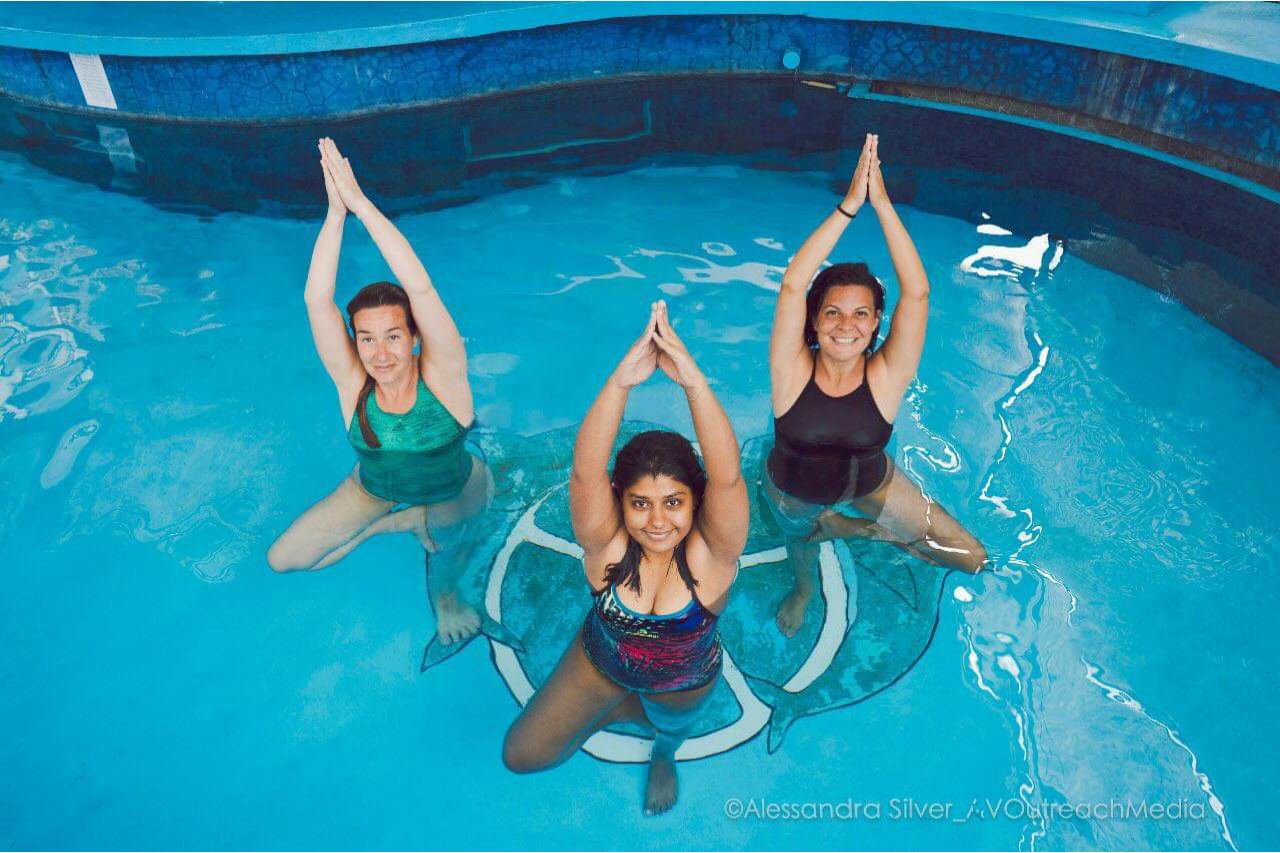Yoga comes in many shapes and forms. This International Yoga Day, we spoke to Yoga practitioners from diverse backgrounds to find out more about the various Yoga disciplines around the world. Aqua Yoga, a practice that merges the tranquility of water with the mindful movements of Yoga, is a fairly young discipline. We sat down with Pooja Gautam, Certified Watsu Practitioner and Instructor and Aqua Yoga Instructor, to explore the incredible benefits and techniques of the practice.
What is Aqua Yoga? Can you tell us about its origins?
Pooja Gautam: Aqua Yoga is based on Yoga poses and stretches modified for water.
Thanks to the decrease in gravity, water allows greater ease of movement, unblocks joints, lengthens and melts muscles, and removes negative tensions, thereby preventing stress, insomnia and anxiety.
I practice Woga® (or water yoga), which is an adaptation of the Hatha Yoga technique in warm water. It was developed by my Swiss aquatic bodywork teacher Gianni De Stefani over the last couple of decades.
When did you start your journey with Aqua Yoga and how has your experience been?
Pooja Gautam: Though I had been acquainted with Yoga since I was a child, it was only in the last decade that I started appreciating its depth and therapeutic effects for the body and mind. So, after I became a certified Watsu® (Water Shiatsu) practitioner, I was keen to combine the healing power of water with the science of yoga. I became a certified Woga® instructor in 2019, and since then I have catered to a diverse set of clients ranging from those with ACL tears, obesity, hip injuries, movement imbalances, mental health issues, among others.
What are some unique physical and mental health benefits of Aqua Yoga?
Pooja Gautam: Due to the resistance of the water, when we move, we increase muscle volume and stimulate the cardiovascular system. The pressure combined with a temperature above 32° helps to decrease muscle tension. The water pressure is, in itself, a uniform massage on the entire body. Hence the whole epidermis and its receptors are activated.
By being in the water, we can strengthen our immune system and stimulate our metabolic activity. The buoyancy of the water allows us to decrease the weight of the submerged body parts by about ten times, thus relieving the joints. Water is a powerful energy reservoir that facilitates the practice of a static or dynamic meditation. The heat of the water (at least 33°, best at 35°) and the resulting well-being, help facilitate introspection. The practice of meditation in hot water promotes awareness of self through a more flexible spine.
Even the great neuroscientists dedicated to the study of the functions of the brain are convinced of the power of water. They discovered that when you float in hot water, in a state of ‘sensory deprivation’ within an environment of peace and quiet, our brain ‘works’ to perfection. It feels good and is more harmonious. The right or ‘intuitive’ side, in charge of regulating emotions and creative activities can finally express itself. While the left or ‘rational’ side—that as Westerners we tend to use too much—can finally ‘rest’. Hot water allows the body to relax, which promotes concentration and meditation, and allows for the possible symbolic work or visualization to take place.
Who can practice Aqua Yoga? Are there any age/gender/physical restrictions?
Pooja Gautam: Aqua Yoga has benefits for everyone as it promotes wellbeing. It is especially helpful in rehabilitation work for people who have difficulty exercising on land.
How popular is Aqua Yoga in India? What can be done to increase awareness about the discipline?
Pooja Gautam: Aquatherapy in India is still in a nascent stage, but it is growing very fast given the immense benefits of immersion in water. It is only a matter of time that aquatherapy, and Aqua Yoga in particular, will get more mainstream.
What are some myths associated with Aqua Yoga?
Pooja Gautam: Some people have the misconception that you need to know how to swim to be able to do Aqua Yoga. That’s not the case at all. In fact, most of my clients are non-swimmers and even aquaphobic.
What kind of exercises are covered in an Aqua Yoga session?
Pooja Gautam: The following are the main aspects of Aqua Yoga:
1. Stretching in the water with asanas derived from Hatha Yoga: Stretching in water is immensely beneficial. The effect of buoyancy, which opposes the force of gravity, is a decrease in the body weight. This results in a reduction of joint contraction and leads to greater freedom and range of motion with less muscle strength, and reduced (or no) pain during movement.
2. Breath awareness work, incorporating elements of pranayama: In the water, we can learn to manage the respiratory flow in very different ways and with a heightened sensibility. Due to the effect of the hydrostatic pressure in the water, there is an increase in intra-abdominal pressure that pushes the diaphragm and increases the work of the respiratory muscles.
3. Meditation: Water is a powerful energy reservoir that facilitates the practice of a static or dynamic meditation. The practice of meditation in water promotes awareness of self through a more flexible spine.
8. What is your wellness mantra?
Pooja Gautam: Movement is medicine.






